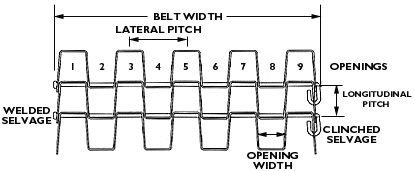
In order to identity a conveyor belt for replacement, follow these seven steps:
1. Measure the Overall Belt Width, including the rods, as depicted below.
2. Count the number of Openings Across the Width of the belt. This figure will always be an odd number.
3. Determine the Belt Gauge; i.e. Standard Duty or Heavy Duty:
a) Determine the height of the strip by placing the belt flat on a table and measuring from the table to the top of the belt. A Standard Duty belt will measure 3/8" and a Heavy Duty belt will measure 1/2", or,
b) Measure the diameter of the connecting rod. Standard Duty belt rods can be 0.105" or 0.120", where Heavy Duty belt rods are 0.192" in diameter.
4. Determine the Mesh Size by measuring the width of the 2nd opening from the belt edge. Be sure to measure at the middle of the opening, shown below.
5. Measure the Longitudinal Pitch of the belt, as shown below.
6. Determine the type of Selvage of the Belt by visual inspection. This will be either Clinched or Welded. Please refer to the diagram below. An example of the Welded Selvage is on the left side of the belt diagram, and an example of Clinched selvage is on the right side of the belt diagram.
7. Determine the belt material. Because Stainless Steels are not magnetic, the use of a magnet can narrow the choice to either Carbon or Stainless Steel. Beyond this, material determination can be done by application.
a) High Carbon belts are generally used for temperature ranges between 500°F and 800°F, and can withstand abrasive environments better than Galvanized Steel Belts. Galvanized steel belts are a lower cost and lower temperature alternative to High Carbon Belts and are resistant to rust.
b) Stainless Steel Belts will either be Type 304 or Type 316. While more expensive, Type 316 Stainless Steel Belts offer greater resistance to corrosion and are stronger than Type 304 Stainless Steel Belts at higher temperatures.

Galvanized Low Carbon Steel (C1015): Most common flat wire belt material used because of low cost and resistance to rust in most plant environments. Galvanized steel can be used in temperatures up to 500 degrees (F), although it is usually limited to 350 degrees (F) as the galvanizing will flake off above this temperature.
Bright High Carbon Steel (C1050): This material is used in the 350 degrees (F) to 800 degrees (F) range for dry non-corrosive environments. High carbon steel provides for higher strength at elevated temperatures and has a greater resistance to abrasion than galvanized low carbon steel.
Type 304 Stainless Steel: This is the standard stainless material used in the food processing industry. It is highly resistant to most corrosive atmospheres and can be used in temperatures up to 1100 degrees (F). However, at temperatures above 800 degrees (F) there can be a loss of corrosive resistance.
Type 316L Stainless Steel:
It is more resistant than T-304 stainless steel to sulfuric, acetic and phosphoric
acids. At elevated temperatures, T-316L stainless is stronger and offers greater
resistance to corrosion than T-304 stainless.
Site Map: The Mat King Web Site in Overview
THE
MAT KING
740 West End Avenue; Suite 1
New York, NY 10025 USA
Phone: (646)998-4208
Fax: (646)998-4073
Phone: 800-442-6544
Fax: 800-Mats-Fax (628-7329)
Phone: 800-442-6544
Fax: 800-Mats-Fax (628-7329)
![]()
|
||||

|